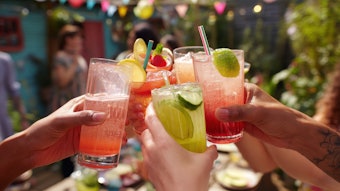Early in 1975, the Bureau of Alcohol, Tobacco and Firearms of the Treasury Department proposed regulations regarding the labeling of Wines and Distilled Spirits. These proposals followed m earlier set of regulations concerning Beer and Malt Beverages, with a hearing on this scheduled for February, 1975. Because of the inter-relationships among these classes of taxed beverages, the Beer/Malt Beverage hearings were rescheduled to be in close proximity to the others, and all finally took place during April, 1975.
With more or less bated breath, the liquor, wine and beer industries (along with suppliers to them) awaited the decision of the Director, Mr. Rex Davis. The Bureau had, on October 8, 1974, formalized an Agreement with F.D.A. through publication in the Federal Register of a “Memorandum of Understanding," in which F.D.A, relinquished control of the labeling of all alcoholic beverage products to BATF provided that they would be labeled “consistent with the [Food, Drug & Cosmetic] Act. In April, 1940, T.C. 224 had unilaterally ceded such supervision to the predecessor agency which, under the Federal Alcohol Act (Administration), had additional resposibilities concerning these products, although they were considered as “foods” by the F.D. & C. law.
During the hearings, very little testimony was given in favor of the promulgated revision, and much oppposition was presented. Among the many arguments against the change were (1) there is no consumer ground swell of demand, most consumers not even reading the present labels, and many consumers not eeven seeing the bottles from which the beverages are poured; (2) difficulty in policing foreign producers vis-a-vis the continual presence of on-premise Treasury agents domestically; (3) non-tariff trade barriers would be erected, against proclaimed public policy; (4) the complexity of prcocessing is such that the identity of the ingredients used in the first pIace is hardly the same as those appearing in the bottled product; (5) recordkeeping requirements would he extremely burdensome (and eventually costly to the consumer) due to the aging process, blending and cross-blending, etc. which takes place in modern wineries, distilleries, rectifiers, et alia; and, (6) the industries are already closely controlled and watched due to the revenue-producing aspect of these “foods,” unlike all other foods (they were even prohibited from consumption from 1918-1933!).










